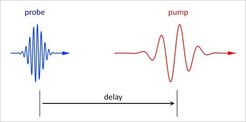
Angle-Resolved Photoemission Spectroscopy (ARPES)
Photoemission Spectroscopy (PES) is based on the photoelectric effect, where photons of energy ℏω in the vacuum ultra-violet (VUV) spectral range release photoelectrons, if the photon energy ℏω exceeds the work function ϕ of the illuminated sample. The photoelectrons are collected by an electrostatic lens and travel through a hemispherical analyzer where they are sorted according to their kinetic energy Ekin and emission angle θ before they are detected on a two-dimensional CCD camera. The binding energy of the electrons inside the crystal can be directly obtained via EB = ℏω-ϕ-Ekin, and the in-plane momentum k∥ follows from k∥ = 0.512√(Ekin)sinθ, so that the two-dimensional image on the CCD detector directly provides the electronic structure along a particular cut through momentum space.

Time-Resolved ARPES
In order to extend ARPES to the time domain, the sample is excited and probed with femtosecond laser pulses. The pump pulses cover the wavelength regime from 800 nm (fundamental wavelength of the Ti:Sapphire laser) to 15 μm (generated by optical parametric amplification and difference frequency generation). The response of the electronic structure is probed by ARPES using either the 4th harmonic of the Ti:Sapphire laser at 6 eV, or high harmonics in the range from 20 to 40 eV.


